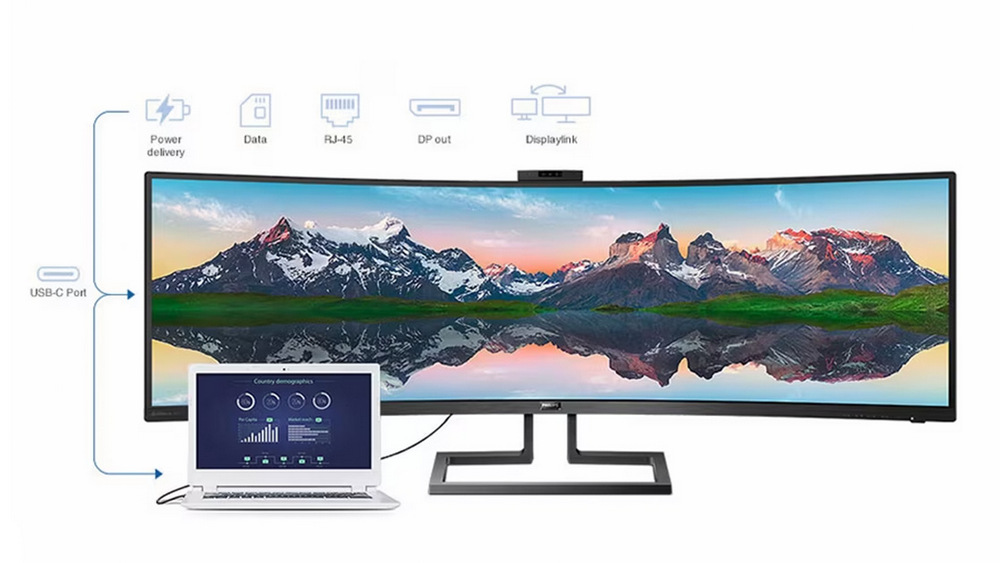![]() 2023/06/06 | MMDInnovationHub
2023/06/06 | MMDInnovationHub
Laptops are getting slimmer and slimmer, to accommodate flexible working weeks and needs. However, that comes with the sacrifice of ports and connectivity options. The industry is slowly moving towards the adoption of USB-C or Thunderbolt ports and cables, which allow impressive data transfer. For example, both USB-C and Thunderbolt appear to be slim cables able to carry both power and data signal from laptop to screen and vice versa. The technology is easy to configure, requiring only one cable with a symmetrical plug, to make any set-up ready for any workload. To learn more about the difference between USB-C and Thunderbolt (spoiler: they are not the same!), jump to page.
However, there is and there will be a need for docking and hubs to simplify connections. For example, professionals might feel the need to expand their workstation from the single laptop to a wide number of peripherals (keyboards, mice, headphones) and add more screen estate with a monitor or two.
Rather than adding an external device, choosing a monitor with built-in USB docking can truly simplify connections and user experience, boosting business productivity and reducing costs. Philips Monitors USB docking solutions offer Power Delivery up to 90W or 100W*, data transfer, RJ-45 and DP out all in one. USB docking is the best solution, specifically designed for corporate and office environments – but not only those.
What is the point of a docking station?
Built-in docking stations expand the number of ports on a monitor (and in a working station). This lets professionals connect more devices or peripherals, without the need to add additional and bulkier external devices to improve and widen connectivity. With the same goal of simplifying connectivity, it eliminates the need to disconnect and reconnect individual wires – making it the ideal option for modern offices offering hybrid working weeks and coworking spaces alike. Docks save time and effort, whilst reducing the risk of the working station being inoperable due to damaged or frayed wires.

Users will all be given the experience of using a PC (with its multiple connection options and ports) while using their portable laptop, just by choosing monitors that include USB Docking stations. With Philips USB Docking displays, users will be able to extend their laptop autonomy without any additional external power supplies (please check official manufacturer specifications for complete details on compatibility), plug all external devices they need directly to the monitor, easily daisy chain multiple monitors, and transfer data, video and power with one cable.
Philips USB docking combines USB-C, RJ45 and DP-out for added convenience, thereby replacing any external bulky docking standalone, reducing unwanted clutter on the desks, and assuring high connectivity.
For professional users that need the most advanced and comprehensive solution, Philips designed a USB Docking Pro, a vertical hybrid docking that allows an even more versatile connectivity that feature universal port replication and assures higher quality for power, data and audio/video delivery. In models such as the Philips 276B1JH or 241B7QUBHEB, the USB Docking Pro is equipped with USB-A with DisplayLink technology that feature universal port replication. With docking monitors with built-in DisplayLink Technology, users can benefit from forwards and backwards USB compatibility with virtually any recent notebook.
Is a docking station better than a hub?
Although for some the terms docks and hubs might appear synonyms, they are not. Both are specifically designed to connect multiple displays and peripherals, while also providing power to the laptop in use with one connection, but docking stations are generally more powerful than a hub. Specifically, they feature more ports than USB-C hubs, and a wider connection.
A single USB-C can already change the user experience (no more chargers, power and signal cable), but built-in USB docking is highly powerful and future-proof, and more suitable for professionals who need more than a simple monitor-keyboard-mouse set-up. Users requiring complex set-ups with multiple monitors should check out Philips monitors with built-in USB docking pro.
Will a USB-C docking station charge my laptop?
Philips USB-C Docking ports deliver up to 90W or 100W* to your laptop or smart devices, bringing order and convenience to your digital workspace. Philips monitors are tested to ensure compatibility with a wide range of laptop and phone brands and models, but please always check with your Notebook user manual or manufacturer for more details.
USB-C docking stations are a great solution to enhance users’ productivity, creativity, and comfort. There is no need for external wires, or to set up the desk every morning – just plug in one single cable to be ready to work.
Do I need a docking station for 2 monitors?
Daisy chaining is easier with a built-in docking solution. Since it is still not possible to daisy chain through USB-C alone, Philips Docking Solutions also include DP out to help you connect multiple displays seamlessly.
For professionals, screen size matters: having more space means that professionals can have more documents, apps and media displayed at the same time, with less toggling through programs, less switching through documents. Daisy-chaining monitors means connecting multiple monitors to each other and then to a single computer, using a DisplayPort cable to connect monitor to monitor, rather than connecting each monitor to graphics board of the single computer or laptop in use. Using DP and a Philips monitor with built-in USB docking enables even more flexibility and comfort, reducing clutter and simplifying cable management.
*Depending on model.